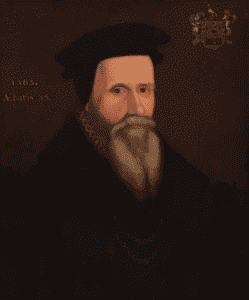Philip Liebson
Chicago, Illinois, United States
 |
| John Caius (1510-1573), Master of Gonville & Caius College, Cambridge. 1563. Unknown painter. Credit: Gonville & Caius College, University of Cambridge. |
Imagine being a physician in a rural community in England in the mid-sixteenth century, always concerned with the reappearance of the Black Death. Late one summer you are faced with a new strange illness. It begins with cold shivers, headaches, and severe diffuse pains leading to exhaustion, and within a few hours to sudden sweating, tachycardia, and delirium. It is clearly not plague since no buboes or eruptions are noted but within hours sleep occurs and then death, usually more rapidly even than with plague.
This was the sweating sickness that periodically attacked Western Europe between 1485 and 1551 and each time disappeared as rapidly as it had occurred. It was only in 1552, after the last epidemic, that a scholarly assessment was written by John Caius, titled A Boke or Counseill Against the Disease Commonly Called the Sweate, or Sweatyng Sicknesse.
Caius was no mere physician, but a polymath. Born in Norwich in 1510 as John Keys, he studied theology in Cambridge at what originally was Gonville Hall, and after obtaining his degree served as a fellow there for six years. He then left for Padua, where he studied under John Baptista Montanus and worked with Andrea Vesalius, with whom he housed for eight months but seem to have fallen out. In 1541 he obtained his MD degree and latinized his name, then spent two years teaching Greek dialectics. Leaving Padua, he studied medicine in Florence and Pisa, and traveled throughout Italy copying and translating ancient Greeks manuscripts, particularly those of Galen, whom he greatly admired.
Returning to England in 1544, he practiced medicine in London, amassing a fortune which he later donated to his Cambridge college. It is believed that he served as physician to Edward VI, Mary I, and Elizabeth I. He continued to translate Galenic manuscripts, and also pursued natural history studies and wrote a book about English dogs.
In 1547 he was elected fellow of the Royal College of Physicians. He became president in 1555 and served until 1560, then again in 1571. He organized the College, instituted more exact record-keeping, enforced the statutes by prosecuting unlicensed practitioners in London, and worked to defend the supremacy of physicians over barber-surgeons. In 1557 he donated almost all of his possessions to Gonville Hall, which became a college and was renamed Gonville and Caius. He was unanimously elected its master in 1559. He refused a salary and continued to make donations in order to improve it and expand its activities, helping it to develop a great medical reputation. He emphasized hands-on anatomical learning and in 1551 personally witnessed the sweating disease epidemic.
He studied zoology, botany, greyhounds, fish, and birds, and published a book on English dogs. He made study of Scriptures in the Greek and Latin, and wrote histories of Gonville Hall and of the University itself. He pioneered the study of anatomy and in 1564 persuaded Queen Elizabeth to annually grant two criminal corpses to Gonville and Caius, and four to the Royal College of Physicians.
In this time England was troubled by the sweating sickness, which appeared around the time of the battle of Bosworth in 1485 and returned in 1508, 1517, 1528, and 1551, each time mysteriously disappearing. He personally observed the epidemic and published his famous manuscript about it.
Though associated with a major Protestant institution, he remained a Catholic. In 1572 the fellows of the college accused him of Catholicism, searched his room, confiscated his books, and burned them. Already suffering from an abdominal complaint, he resigned from the University and died the following year.
The cause of the sweating sickness has remained unknown. It has been recently speculated that the sweating sickness was caused by a hantavirus, a rare infectious disease carried by rodents producing respiratory illness and frequently progressing to death. However, determining the infective agent six hundred years after the illness has disappeared is impossible, and even the causes of death of those who died within the past two centuries or so such as Mozart, Schubert, and Chopin are open to speculation.
References
- Liebson P.R. The sweating sickness in Tudor England: a plague of the Renaissance. Hektoen International. Winter 2013 – Volume 5, Issue 1, (History Essays).
- Cagliuso D.M. Progressive reactionary: The life and works of John Caius, MD. Thesis submitted to the Graduate Faculty of the Kenneth P. Dietrich School of Arts and Sciences. University of Pittsburgh, 2015.
PHILIP R. LIEBSON, MD, received his cardiology training at Bellevue Hospital and the New York Hospital Cornell Medical Center, where he served on the faculty for several years. A professor of medicine and preventive medicine, he has been on the faculty of Rush Medical College since 1972 and held the McMullan-Eybel Chair of Excellence in Clinical Cardiology.
Summer 2021 | Sections | Physicians of Note

Leave a Reply